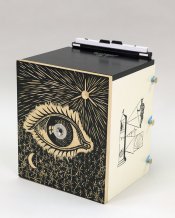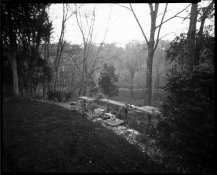I agree with the ToadMen in recommending PinholeDesigner, a free download from
www.pinhole.cz. The last time I looked at
www.mrpinhole.com (years ago) it wasn't as useful to the technically inclined photographer as PinholeDesigner. The default constant in PinholeDesigner is 1.9 as determined by Lord Rayleigh well over a hundred years ago. He was a scientist first and perhaps a photographer second. His constant is apparently derived more from theoretical and mathematical considerations than from actual photography. His classic article on the subject is available online. I can send you a link to it if you want to spend more time wrestling with math than making photos. After photographing resolution charts, I prefer a smaller constant, about 1.4. So do some others on
www.f295.org. Such smaller constants are apparently used by some of the ready-made pinhole cameras.
Contrary to some pinhole photographers, the size of the pinhole is fairly critical. Deviating from the ideal diameter by 10% can result in a noticeable decrease in image resolution. An optimum pinhole can resolve standard resolution charts with a line/pair spacing less than the pinhole diameter. Also contrary to conventional wisdom, pinhole cameras exhibit chromatic aberration and astigmatism, although moderate amounts in normal focal lengths.
An analysis of pinhole images and formulae shows that the larger the format and the wider the angle of coverage, the better the detail can be recorded in the center of the image. With ideal cameras, doubling the format size doubles the effective "pixel count." In other words, a large format pinhole image optically or digitally reduced to a small size can exhibit more detail than a pinhole image filmed at the small size. It takes a fairly large difference in format sizes for this to be conspicuous.
Wide angle pinhole cameras exhibit considerable light and sharpness loss towards the image edges. In home-made wide angle pinhole cameras, there is a way of slightly increasing illumination. but at the cost of decreasing contrast, near the edges of the image. In addition to the image forming pinhole, four more pinholes are mounted in about the same plane, but in front of the corners of the negative. Light through these is diffused and reduced so it adds a little, but not much, illumination to the corners of the image. This has the effect of giving the corners slight pre-exposure, just as was done in the heyday of film to insure the capture of some detail in shadows.
Back to Bethe's question, for a starter I'd use a focal length of about 6" and a pinhole diameter of about 0.016" for photographing fairly distant subjects. This means f/375. Ouch! For close-ups, the pinhole diameter can be reduced slightly. If interested, I can look up the formula for this reduction. A 6" focal length will cover about 90 degrees, corner to corner. Light fall-off at the corners will be about two stops if the pinhole edges are very thin. This makes film better than the more contrasty photo paper for image capture. The corner fall-off can be used for esthetic effect.
 TIA!
TIA! TIA!
TIA!









